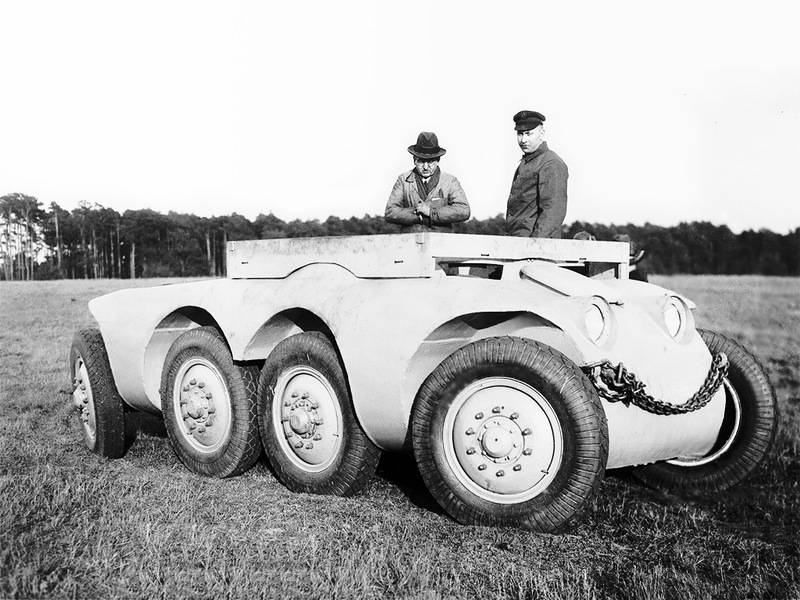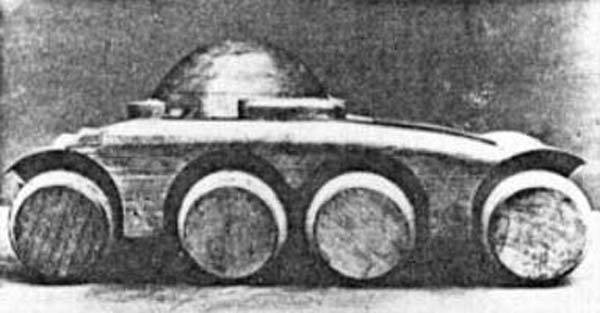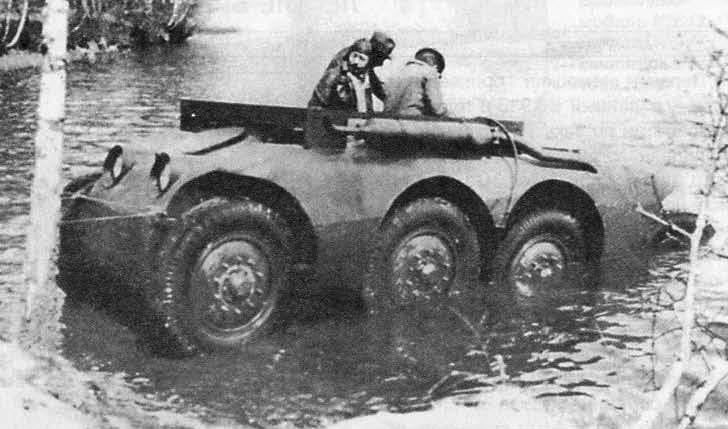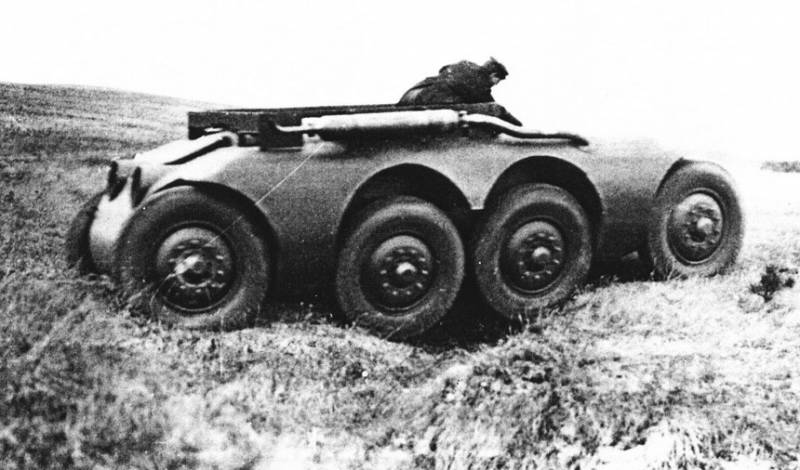Daimler-Benz DB-ARW armored car (Germany)
The goal of the Mannschafstransportwagen or MTW program was to create a new armored vehicle based on a specially designed chassis capable of carrying machine guns or gun armaments. Such a technique, as conceived by the German military, was to support the troops on the battlefield, as well as solve some other tasks. The study of the prospects for armored vehicles and the formation of technical specifications continued until the 1927 year, after which several German companies were attracted to the MTW program. They had to create new projects and build experienced combat vehicles.

DB-ARW armored car on the ground
The design of new armored vehicles was commissioned by Daimler-Benz, Magirus and Büssing-NAG. In accordance with the technical assignment, the engineers of these organizations had to create wheeled combat vehicles with anti-bullet protection and artillery weapons. The armored car should be built on the basis of its own specially designed chassis, capable of providing high mobility, maneuverability and the ability to cross water obstacles by swimming.
The same requirements for all three projects led to specific consequences. Two of the proposed combat vehicles developed by Magirus and Daimler-Benz turned out to be very similar to each other both in their design and in appearance. Nevertheless, some minor details of the exterior make it easy to distinguish between experienced armored cars of two different types.
All three armored cars of new models were developed in the framework of the overall program, and therefore received similar names. So, Daimler-Benz armored car carried the DB-ARW designation. The first two letters designated the developer, and ARW was deciphered as Achtradwagen - "The eight-wheeled car".
The similarity of the two samples of armored vehicles was due primarily to the use of the same design solutions. The DB-ARW project involved the use of a complex-shaped supporting hull to protect against rifle bullets. weapons and splinters. The body should be equipped with a power plant and a four-axle undercarriage. The internal volumes of the hull were divided into several compartments. The front part of the vehicle contained the control compartment, the combat compartment was placed in the center, and the aft compartment was placed under the engine.
As in the case of the M-ARW armored car, the body for the DB-ARW was proposed to be assembled from several large metal aggregates. All details of the reservation, regardless of the form and location, had a thickness of 13,5 mm. At the same time, however, due to the different angles of inclination, certain areas of protection could be distinguished by a greater reduced thickness. The specific shape of the hull contributed to this effect, which to a certain extent increased the overall level of protection.
It was proposed to use a large frontal hull assembly, made in the form of several curved armor plates. Its front part was smoothly bent at the level of the axis of the front wheels, and also mated with an inclined upper surface. At the junction of the two surfaces were placed large protruding headlight housings. On the sides of the latter were located the front sections of the wheel arches of the first axis, which determined the further width of the hull along its entire length.

Wooden layout of the future car. Hemispherical tower used
Like the armored car from Magirus, the DB-ARW had a cross-section of the hull, which was distinguished by a certain complexity. Separate sections of the hull were smooth, and curved were placed next to them. In addition, on the sides of the hull were located large wheel arches, the inner surface of which was also part of the armored hull and had to be made of the appropriate material. The aft of the hull received a sloping roof, smoothly mated with the sides and the rear unit.
The DB-ARW project proposed the use of a hemispherical tower with devices for mounting barreled weapons. To install the tower was intended relatively small flat section of the roof, equipped with a shoulder strap. Interestingly, the proposed form of the tower was later retained, while for the armored car M-ARW developed an updated dome.
In the aft compartment of the Daimler-Benz armored car, there was a M36 DB petrol engine rated at 100 hp. With the engine connected mechanical transmission. Its main element, according to some sources, was the gearbox, which had five forward and reverse speeds. Using a set of shafts, gearboxes and differentials, torque was transmitted to eight driving wheels. In addition, there was a separate shaft for the propeller, bred out through a sealed assembly in the stern sheet.
To obtain the maximum possible mobility characteristics, a four-axle all-wheel drive chassis with relatively large diameter wheels was used. Bridges with a spring suspension were located at unequal intervals: the first and last intervals were significantly longer than the distance between the second and third wheels. The first and fourth axes had control mechanisms that increased maneuverability. As a supplement to the wheel propulsion, a propeller screw was used, which was mounted on the shaft in the stern.
The project involved the use of a combined machine-gun armament. In the frontal part of the turret, the installation could be mounted for the 37-mm cannon and the 7,92-mm machine gun. One of the latest developments of the company Rheinmetall was considered as the “main caliber”, and the Schwarlzoze with a water-cooled barrel could become a regular machine gun. The dimensions of the fighting compartment made it possible to place racks and stowage for transporting several dozen artillery shells and a large number of boxes with cartridge belts.
The crew of an armored car Daimler-Benz DB-ARW was to consist of four people. In front of the hull, side by side, were placed the jobs of the driver and his assistant. Access to such a separation of control was provided by a hatch in the sloping part of the forehead. Above the driver and assistant there were low cutting-out towers with large inspection hatches in the front.
Two other jobs were located in the fighting compartment, under a rotating turret. The commander and loader were to control the weapon. The duties of the commander was to monitor the situation, search for targets and aiming weapons. There is reason to believe that the project provided for equipping the tower with viewing devices and one large hatch for all the “inhabitants” of the combat compartment. Similarly, the towers of other armored vehicles of the MTW program were completed.
The uniform technical task and the use of similar solutions led to the fact that the DB-ARW and M-ARW armored cars differed little in design and size. The length of the armored car from the Daimler-Benz reached 5,5 m, the width was about 2,2 m, and the height was about 2 m. The speed on the highway could reach 7-60 km / h, the range of at least 65-200 km. Propeller allowed to move through the water with a sufficiently high speed.
The development of the Mannschafstransportwagen family projects was completed in 1928, and the necessary documentation was submitted to Reichswehr experts. The military reviewed the proposed armored vehicles and made preliminary conclusions. On the basis of the main features and design characteristics, the Magirus project looked the most successful. However, it was decided to continue parallel work on several new samples. Three development companies were assigned to build experienced armored cars.
According to some reports, the preparation for the tests began with the construction of a wooden model of the future armored car. According to the results of his analysis, some changes were made to the original project, after which the documentation was transferred to production. A prototype DB-ARW armored car was built in 1929 year. This machine, first of all, was intended to test the real capabilities of the chassis, and therefore had a specific configuration.
The first prototype of an armored car from Daimler-Benz had a full-fledged power unit and transmission with a full set of chassis units. The body of the original design, which had an unusual shape, according to some data, was assembled from structural steel. The tower was not installed. In place of the tower on top of the hull mounted low side superstructure. Its front part was at the level of the forehead of the driver and assistant towers. In the future, when obtaining the desired results, it was possible to install a turret with a weapon or its weight imitators on an experienced armored car.
Due to the existing restrictions, Germany could not conduct a full cycle of testing of experimental equipment at its sites. In this regard, the Magirus M-ARW armored car, after passing factory tests, went to the Kama school, previously opened in the Soviet Union. The DB-ARW armored car, as far as is known, was able to be checked on German sites without the risk of finding work by third countries.

Tests on the water: armored car climbs ashore
Chassis tests without reservation and turret with weapons showed that the project DB-ARW, in general, meets the requirements of the customer. Armored car showed good performance on the roads, and also had sufficient throughput and mobility on rough terrain. Movement on the water also was not associated with any difficulties. It should be noted that tests of a different type of prototype machine, conducted on Soviet territory, passed with similar results. At the same time, however, unlike the DB-ARW, an armored car from Magirus received a turret with weapons and was tested at a shooting range.
The Mannschafstransportwagen / MTW experimental equipment showed good results, and promising armored cars could get a chance to go into service. However, like any new equipment, they had certain disadvantages that reduced the interest of a potential customer. As a result, the specific ratio of pros and cons led to the abandonment of all developed projects.
Daimler-Benz DB-ARW armored car had good mobility and maneuverability on rough terrain. In this case, his body could protect the crew from small arms and debris. In the tower it was possible to install machine guns or a combined system with a machine gun and a cannon, having a sufficiently high firepower. Like a parallel-designed machine, the DB-ARW could show itself well on the battlefield.
However, there were serious drawbacks. In the first place, the reason for criticism was the overly complex case design. It was proposed to assemble it from several large curved units, the manufacture of which was distinguished by complexity and high cost. Also during the tests, certain weaknesses of the power plant, running gear, etc., manifested themselves, which could impede the operation of equipment.
In 1932, the command, after reviewing the test results, decided to abandon the armored vehicles built under the Mannschafstransportwagen program. They turned out to be too complicated and expensive for mass construction, meeting the requirements of the army. At that time, Germany simply could not afford the mass production of such equipment, regardless of its characteristics and capabilities. The further development of the MTW family projects was abandoned. Now it was proposed to rearm the Reichswehr with the help of other equipment.
The only built prototype of the Daimler-Benz armored car that did not receive protection, the tower and armament, remained for some time at the test site, where it was used in new research. All of the Mannschafstransportwagen equipment was now designed to gather information needed to design new combat vehicles. After the completion of such studies and, probably, in connection with the development of a resource, an experienced DB-ARW was disassembled as superfluous.
The MTW program did not produce the desired results. The armored cars created in the course of these works could not enter service and get into mass production. Nevertheless, the German specialists were able to gather the necessary information and gain experience. Already at the beginning of the thirties, experience and best practices were used in the following projects. By the middle of the decade, the first models of new armored vehicles were adopted, the creation of which was largely contributed to the DB-ARW armored car.
Based on:
http://aviarmor.net/
http://wehrmacht-history.com/
https://forum.warthunder.com/
http://shushpanzer-ru.livejournal.com/
Chamberlain P., Doyle H. Encyclopedia of the German tanks The Second World War 1933-1945. AST / Astrel, M .: 2003.
- Ryabov Kirill
- 477768.livejournal.com, Aviarmor.net

Information